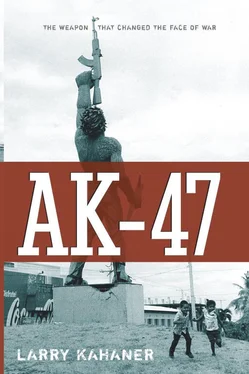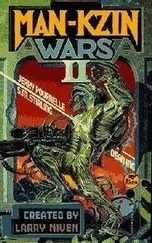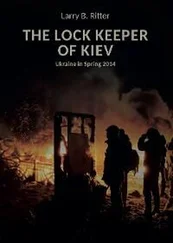Larry Kahaner - AK-47
Здесь есть возможность читать онлайн «Larry Kahaner - AK-47» весь текст электронной книги совершенно бесплатно (целиком полную версию без сокращений). В некоторых случаях можно слушать аудио, скачать через торрент в формате fb2 и присутствует краткое содержание. Город: Hoboken, Год выпуска: 2007, ISBN: 2007, Издательство: John Wiley & Sons, Inc., Жанр: История, military_history, на английском языке. Описание произведения, (предисловие) а так же отзывы посетителей доступны на портале библиотеки ЛибКат.
- Название:AK-47
- Автор:
- Издательство:John Wiley & Sons, Inc.
- Жанр:
- Год:2007
- Город:Hoboken
- ISBN:9780470315668
- Рейтинг книги:3 / 5. Голосов: 1
-
Избранное:Добавить в избранное
- Отзывы:
-
Ваша оценка:
- 60
- 1
- 2
- 3
- 4
- 5
AK-47: краткое содержание, описание и аннотация
Предлагаем к чтению аннотацию, описание, краткое содержание или предисловие (зависит от того, что написал сам автор книги «AK-47»). Если вы не нашли необходимую информацию о книге — напишите в комментариях, мы постараемся отыскать её.
AK-47 — читать онлайн бесплатно полную книгу (весь текст) целиком
Ниже представлен текст книги, разбитый по страницам. Система сохранения места последней прочитанной страницы, позволяет с удобством читать онлайн бесплатно книгу «AK-47», без необходимости каждый раз заново искать на чём Вы остановились. Поставьте закладку, и сможете в любой момент перейти на страницу, на которой закончили чтение.
Интервал:
Закладка:
Using the AKs also gave GIs a better understanding of the weapon they encountered most often. All too frequently, though, they learned about the AK’s power when the 7.62mm rounds pierced their body armor.
IN THE LATE 1990s, soldiers were issued the Interceptor Multi-Threat Body Armor System that provided protection against shrapnel and 9mm rounds fired from low-velocity handguns. It was better than the twenty-five-pound Vietnam-era “flak jackets” that protected only against shrapnel, but it was still not up to the demands of Iraq as it offered no protection against 7.62mm rounds fired from AKs.
What could stop heavy fire, however, was the Interceptor with ceramic plates inserted into pockets on the vest. The pockets were strategically placed to offer protection for vital organs. Although their exact composition is classified, these Small Arms Protective Inserts—known to the soldiers as SAPI (Sappy) plates—can stop AK rounds and even light machine-gun rounds. The full vests cost about $1,500 each retail and can be bought with neck- and crotch-protection attachments. Even with the plates, the vests weigh 16.4 pounds, much less than the Vietnam-era flak jackets.
When the war in Iraq began, few soldiers had the protective inserts. Even months into the fighting, well after the fall of Baghdad as urban warfare escalated, about 30 percent of soldiers had not been issued the new vests. By the summer of 2003, congressional offices were receiving letters from soldiers and their families asking why these protective vests were not given to their soldiers even though Congress in April had specifically earmarked $310 million in the $87 billion appropriation for the Iraq war to buy 300,000 vests.
At hearings, lawmakers read letters from angry parents who had bought the inserts for their children with their own money and mailed them to Iraq. Small towns paid for vests with neighborhood fund-raisers and bake sales. Congressmen also brought up reports about GIs who duct-taped plates sent them by family members to old-style flak jackets. Soldiers complained that they were forced to share SAPI plates and vests, offering them to comrades who were heading into immediate combat.
The protective plates were so crucial to GIs’ survival that they were touted in the raw lyrics of the rap album Live from Iraq produced by members of Taskforce 112 of the 1st Calvary Division who called themselves 4th25 (pronounced “fourth quarter,” like the do-or-die period of a football game). Recording in a plywood shack with old mattresses for soundproofing, the group expressed their frustration at poor equipment and lack of army support for their mission, which included protecting Baghdad airport. Thousands of albums were sold over the Internet and through regional music stores around the Fort Hood, Texas, area where the men were based. The song “Stay in Step” told a story of survival: “Bloody desert combat fatigues, dusty and ammoless M-16 with a shredded sling… Hit in the head and shoulder but still taking deep breaths/Cause I’m in Kevlar and Sappy plates in my flak vest…”
Members of Congress wrote letters to Donald Rumsfeld demanding an explanation. “Not only did the Pentagon fail to provide U.S. soldiers with adequate lifesaving armor prior to the start of combat operations, but it took your Department seven months after hostilities began to even approach Congress with a request for funding for this essential equipment,” wrote Ohio congressman Ted Strickland. “This is particularly startling considering that the latest-model Kevlar vests, which receive ‘rave reviews’ from field commanders, reportedly cost only $517 per unit [just for the plates]. This seems like an incredibly small price to pay in exchange for equipment that has been credited with saving at least 29 U.S. lives so far.”
In response, Chief of the U.S. Central Command General John Abizaid testified, “I can’t answer for the record why we started this war with protective vests that were in short supply.” In private, Pentagon officials reiterated their surprise at the guerrilla war they found themselves fighting. Abizaid promised that all ground troops would have the vests and plates by year’s end.
Body armor was not the only problem. AKs were making Swiss cheese out of vehicles, too. The High Mobility Multipurpose Wheeled Vehicle (HMMWV), commonly known as the Humvee, had become the Jeep of the modern military. With four-wheel drive, automatic transmission, a low center of gravity, and even a snorkel that allowed it to operate under sixty inches of water, the Humvee was the major transportation vehicle for American troops. It was designed to quickly bring troops to the front lines, but the Iraq war had no front line and no predictable point of contact with the enemy. Combat was wherever the insurgents decided it was. The Humvee proved to be a liability in many situations. Although its standard armor plating made it much safer for passengers than the standard army Jeep, it was vulnerable to close-range AK fire as well as IEDs, or improvised explosive devices, that were being deployed by enemy soldiers. The Humvee armor was designed for far-off AK fire and shrapnel but not close-in assaults.
Enterprising GIs raided junkyards and scrap heaps to find steel plates and other heavy metal pieces to bolt to their Humvees in an attempt to protect themselves from attack. Sometimes they would fill buckets with sand and hang them from the vehicle’s side panels. The soldiers dubbed this jury-rigged setup “hillbilly armor” and “gypsy racks,” and as pictures of these makeshift vehicles reached the U.S. public, it was becoming clear that GIs were fighting under conditions that Department of Defense officials had not anticipated. At a town hall-type meeting in Kuwait with Secretary Rumsfeld in December 2004, a National Guard soldier asked why soldiers had to rummage through local landfills for scrap metal and other materials to up-armor their vehicles.
The ever cryptic and aloof Rumsfeld shrugged. “You go to war with the army you have,” he said, a response that reverberated throughout the United States as angry members of Congress continued to question the Department of Defense’s planning and execution of a war that was growing unpopular as the U.S. death toll rose.
The controversy grew as the military retrofitted, or “uparmored,” Humvees that were not designed to carry the extra weight. This additional burden produced excessive wear and tear and mechanical breakdowns, even rollovers and accidents, not to mention the additional fuel consumed by the heavier vehicles, which increased the burden on supplies.
It seemed to many that the war in Iraq was being fought with too few soldiers, inadequate small arms, subpar body armor, and ill-matched vehicles. And there was more embarrassment ahead. The newly forming Iraqi army, trained by the U.S. military and civilian contractors to defend their country, refused American-made M-16s or M-4s. They insisted on being issued AKs, and the United States was forced to comply.
THE COALITION PROVISIONAL AUTHORITY published an RFP, or Request for Proposal, for “brand new, never-fired, fixed stock AK-47 assault rifles with certified manufacture dates not earlier than 1987.” In addition, each rifle had to include four magazines, magazine pouches, a bayonet, sling, and cleaning kit. Officials said they wanted a single source of the weapons. The ultimate shipment was to be thirty-four thousand rifles.
The request appeared ludicrous and humiliating on several levels. First, it bolstered the belief that the M-16 and M-4 were not up to the new realities of war. If so, why were GIs using these weapons? Second, if the Iraqis wanted AKs, why not issue them from the hundreds of thousands of AKs found in arsenals and stockpiles throughout the country? (Before the contract was awarded, the nascent Iraqi army was being outfitted with AKs from Iraqi stockpiles and from Jordanian army stocks.) Around the same time that the RFP went out, U.S. troops found about a hundred thousand AKs in Tikrit, a city north of Baghdad. Reports of similar discoveries were coming in almost daily. Some of these weapons were used but many were new and unused, purchased by Hussein’s regime and stored in their original boxes.
Читать дальшеИнтервал:
Закладка:
Похожие книги на «AK-47»
Представляем Вашему вниманию похожие книги на «AK-47» списком для выбора. Мы отобрали схожую по названию и смыслу литературу в надежде предоставить читателям больше вариантов отыскать новые, интересные, ещё непрочитанные произведения.
Обсуждение, отзывы о книге «AK-47» и просто собственные мнения читателей. Оставьте ваши комментарии, напишите, что Вы думаете о произведении, его смысле или главных героях. Укажите что конкретно понравилось, а что нет, и почему Вы так считаете.











